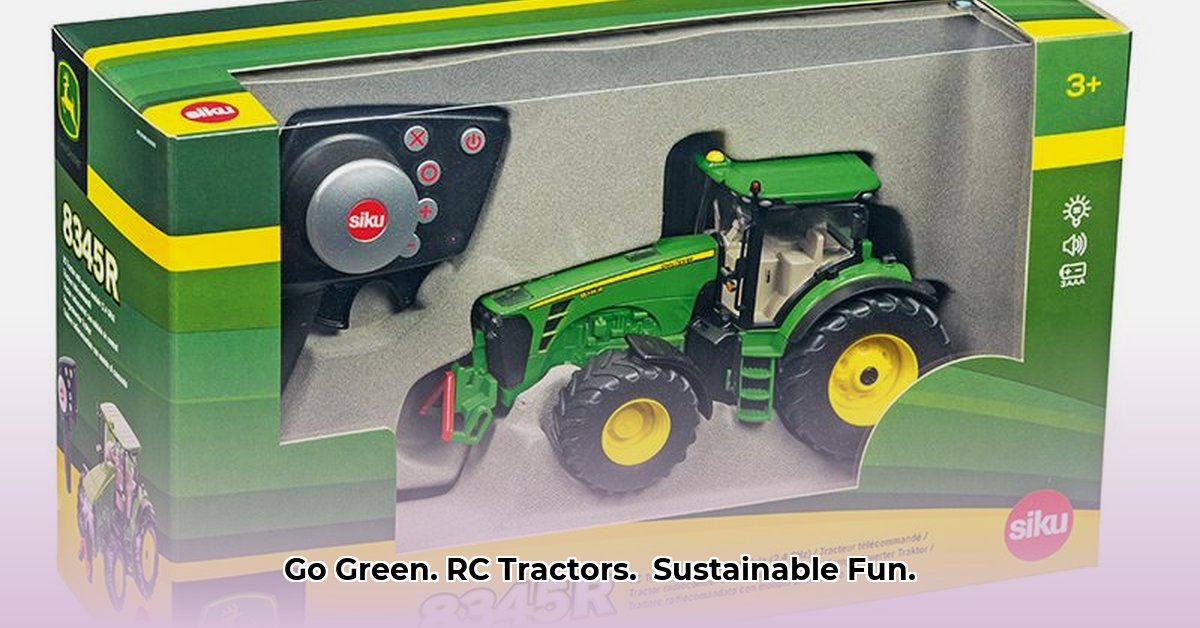
My son, Leo, adores tractors. Seriously, he's obsessed. Books, posters, drawings—you name it. So, when he asked for a remote-control tractor, I was excited… until I considered the plastic, the batteries, the environmental impact. This isn't just about a toy; it's about responsible choices and building a greener future. This article explores the world of eco-friendly remote-control tractors, examining sustainability in toy manufacturing and guiding you to make informed choices. For maintaining your yard while being eco-conscious, check out these lawn tractor accessories.
The Green Revolution in Toy Tractors: A Growing Market
The demand for eco-conscious toys is soaring. Parents are increasingly aware of the environmental impact of their purchases and actively seek sustainable alternatives. This shift is fueling a significant increase in demand for eco-friendly toys, including remote control tractors. But what defines a truly "sustainable" remote control tractor? It's not just about a green label; it’s about a holistic approach.
Did you know that the market for sustainable toys is projected to grow at a double-digit rate in the next five years? This reflects a growing consumer awareness and demand for eco-friendly products.
Beyond the Buzzwords: Defining Sustainable Toy Tractors
Sustainability in remote-control tractors encompasses every stage of its life cycle. This includes material sourcing, manufacturing processes, packaging, and end-of-life management. Key aspects include:
Sustainable Materials: Many companies are using recycled plastics, reducing reliance on virgin resources. Some are even exploring bioplastics from renewable sources like corn or sugarcane, minimizing the environmental footprint.
Responsible Manufacturing: Shifting to renewable energy sources like solar or wind power during production significantly reduces carbon emissions. This commitment to clean energy is increasingly crucial.
Eco-Friendly Packaging: Minimizing packaging and using recyclable materials reduces waste and environmental impact. Think less packaging, more planet.
End-of-Life Solutions: Reputable companies implement take-back programs, allowing customers to return used tractors for recycling or responsible disposal. This closed-loop system minimizes waste, preventing tractors from ending up in landfills.
Carbon Offsets – A Partial Solution: While carbon offsetting programs aim to compensate for emissions, they shouldn't be the sole focus. A holistic approach addressing all aspects of the product lifecycle is crucial for true sustainability.
"The true measure of sustainability isn't just about carbon offsets; it's about a comprehensive lifecycle approach," says Dr. Emily Carter, Professor of Chemical and Biomolecular Engineering at Princeton University.
Decoding the Green Claims: Spotting Greenwashing
Navigating eco-friendly claims can be challenging. "Greenwashing" – misleading marketing tactics – is a concern. To identify genuinely sustainable tractors:
Transparency is Paramount: Reputable companies openly share their manufacturing processes and material sourcing. Opacity is a red flag.
Independent Certifications: Look for independent third-party certifications from reputable organizations. These provide assurance the product meets specific sustainability standards.
Durability Matters: A durable, long-lasting tractor reduces the need for replacements, minimizing waste. High-quality construction often signifies a commitment to longevity.
Are there specific certifications that signify a truly sustainable product? Yes, investigating independent certifications that verify claims is paramount.
The Future is Green: Innovations in Sustainable Toys
The future of sustainable remote-control tractors looks promising:
Biodegradable Materials: Research into biodegradable materials is paving the way for fully compostable tractors, leaving minimal environmental impact.
Solar-Powered Tractors: The development of solar-powered tractors could eliminate battery waste and provide cleaner energy.
Closed-Loop Manufacturing: This system reuses and repurposes materials throughout the product lifecycle, fostering a circular economy with minimal waste.
"The development of biodegradable materials is a game-changer," states Dr. Anya Petrova, Materials Scientist at MIT. "We're moving towards toys that will seamlessly integrate with natural ecosystems at the end of their lifespan."
Your Action: Making a Difference, One Tractor at a Time
Choosing sustainable remote-control tractors is more than just a purchase; it's a powerful statement. By supporting companies committed to sustainability, you influence the toy industry and promote a more responsible future.
Actionable Steps for Eco-Conscious Parents:
Thorough Research: Investigate the manufacturer's sustainability claims. Look beyond marketing and understand their processes.
Seek Independent Reviews: Read reviews to assess the toy's durability and longevity. Real-world feedback is invaluable.
Consider the Entire Lifecycle: Examine materials, manufacturing, and disposal strategies. A holistic approach is essential.
Support Responsible Brands: Support companies committed to sustainability. Your buying habits can influence the market.
Stay Updated: Remain informed about innovations and certifications in sustainable toys.
Weighing the Pros and Cons: A Balanced Perspective
| Feature | Pros | Cons |
|---|---|---|
| Environmental Impact | Reduced carbon footprint, less waste generation, use of recycled materials | Higher initial cost compared to conventional toys |
| Durability | Longer lifespan, reducing the need for replacements | Might require more robust construction, potentially increasing the initial investment |
| Material & Manufacturing | Use of renewable resources, ethical sourcing practices | Limited material options, potentially longer production times, higher costs |
| Transparency & Certifications | Enhanced accountability, increased consumer trust | Verification of claims crucial; some certifications might present varying levels of rigor |
Choosing sustainable toys is an investment in a greener future. By making informed choices and supporting responsible companies, we can build a brighter, more sustainable world for our children.